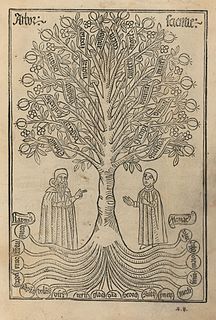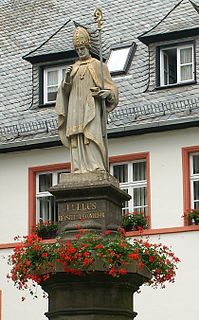
The history of public transport authorities in London details the various organisations that have been responsible for the public transport network in and around London, England from 1933 until 2000 and have used the London Transport brand. Their responsibilities have encompassed the buses, coaches, trams and the London Underground. The period began with the creation of the London Passenger Transport Board, which covered the County of London and adjacent counties within a 30-mile (48-km) radius. This area later came under the control of the London Transport Executive and then the London Transport Board. The area of responsibility was reduced to that of the Greater London administrative area in 1970 when the Greater London Council, and then London Regional Transport took over responsibility. Since 2000, the Greater London Authority has been the transport authority and the executive agency has been called Transport for London; ending the 67-year use of the London Transport name.
Wimbledon usually refers to:

Ramon Llull, T.O.S.F. was a mathematician, polymath, philosopher, logician, Franciscan tertiary and writer from the Kingdom of Majorca. He is credited with writing the first major work of Catalan literature. Recently surfaced manuscripts show his work to have predated by several centuries prominent work on elections theory. He is also considered a pioneer of computation theory, especially given his influence on Leibniz.

Stonebridge Park is a National Rail suburban rail and London Underground station in Tokyngton and Stonebridge, north-west London. The station is served by services operated by Arriva Rail London and London Underground Limited services. It is on both the London Overground Watford DC line and London Underground Bakerloo line. It is located on Argenta Way, and is named after the nearby junction connecting the North Circular Road (A406) with the Harrow Road (A404).

Wembley Central is an interchange station on the West Coast Main Line (WCML), London Overground and London Underground on the Watford DC line in Wembley, in north-west London, served by suburban services operated by London Underground Limited (LUL) and Arriva Rail London and regional services operated by London Northwestern Railway and GTR Southern services. It is on the modest-sized east-west High Road. The station serves Wembley Stadium and the nearby Wembley Arena.
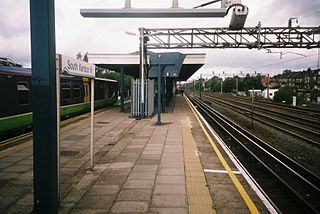
South Kenton is a National Rail suburban rail station in Kenton, north-west London. The station is served by suburban services operated by Arriva Rail London and London Underground Limited (LUL) services. It is on both the London Overground Watford DC line and Bakerloo line between Kenton to the north, and North Wembley to the south. It is located between The Link in the Sudbury Court Estate of North Wembley, and Windermere Grove in Kenton, in the Wembley postal area.

Metronet Rail was one of two infrastructure companies in a public-private partnership with London Underground.

In 1989, the first 'Steam on the Met' event took place, and London Underground, hired British Rail coaching stock for the excursions. It was found that it was actually cheaper to buy the coaches instead of hiring them. Thus, London Underground has acquired numerous former British Rail coaching stock for these special excursion trains on the Metropolitan line, usually hauled by either steam locomotives, or the preserved electric locomotive No. 12 "Sarah Siddons". The fleet consisted of several Mark 1 and Mark 2 vehicles, and eight former British Rail Class 438 electrical multiple unit trailer set vehicles. The two coaches bought in the late 1980s were initially painted in red, white and blue of LUL. After the acquisition of more coaches in 1992, all vehicles were painted in the maroon livery of the Metropolitan Railway. They were normally based at West Ruislip depot.
Opéra-ballet is a genre of French Baroque lyric theatre that was most popular during the 18th century, combining elements of opera and ballet, "that grew out of the ballets à entrées of the early seventeenth century". It differed from the more elevated tragédie en musique as practised by Jean-Baptiste Lully in several ways. It contained more dance music than the tragédie, and the plots were not necessarily derived from classical mythology and allowed for the comic elements, which Lully had excluded from the tragédie en musique after Thésée (1675). The opéra-ballet consisted of a prologue followed by a number of self-contained acts, often loosely grouped around a single theme. The individual acts could also be performed independently, in which case they were known as actes de ballet.
SEEBOARD, formerly South Eastern Electricity Board (SEEB), was a British electricity company. The electrical power industry in the United Kingdom was nationalised by the Electricity Act 1947, when over 600 electric power companies were merged into twelve Area Boards, one of which was the South Eastern Electricity Board. It acquired the former Princes Hotel on the seafront in Hove, East Sussex, and converted it into its headquarters. The building was refurbished and substantially extended between 1979 and 1981.
London Regional Transport (LRT) was the organisation responsible for the public transport network in Greater London, England between 1984 and 2000. In common with all London transport authorities from 1933 to 2000, the public name and operational brand of the organisation was London Transport.
To clip and scotch a set of railway points uses two pieces of equipment to temporarily lock a set of points into a particular position. The point clip clamps the end of a moving rail of a set of points to its associated stock rail, and the scotch is a timber wedge used to ensure that the other moving rail is kept away from its associated stock rail. In this way the points are fixed in either the 'normal' or 'reverse' positions and cannot be moved by the usual setting mechanisms. For infrequently used points, this guards against mechanical failure of the points leaving them in a condition to derail trains. The 'clip and scotch' method can also be used to positively deny access to the turnout or mainline.
Central line or Central Line may refer to:
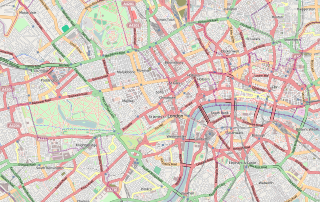
Ludgate Circus was a planned London Underground station that would have formed part of "phase 2" of the Fleet line had it been completed. Taking its name from the nearby Ludgate Circus in the City of London financial district, preliminary preparation work was begun in the 1970s, but the plan was later postponed due to lack of funds.

Jean-Baptiste Lully was an Italian-born French composer, instrumentalist, and dancer who spent most of his life working in the court of Louis XIV of France. He is considered a master of the French Baroque style. Lully disavowed any Italian influence in French music of the period. He became a French subject in 1661.
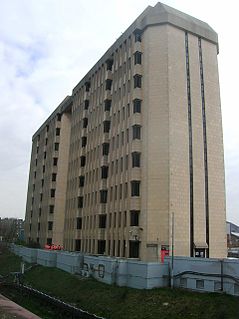
West Ashfield underground station is a mock-up London Underground District line station on the third floor of Ashfield House in West Kensington. It is used for staff training purposes and was opened in 2010 at a cost of £800,000.
New Cross Gate Depot is a railway depot in New Cross, South East London. The depot is situated on the London Overground East London Line and is to the north of New Cross Gate station beside the Brighton Main Line. It replaced the smaller New Cross Depot that serviced the predecessor London Underground line.


